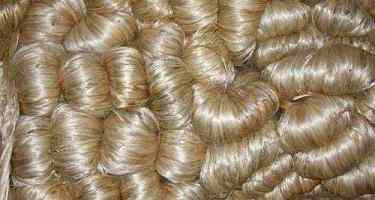Jute-bales - WDRA
Jute
Commodity Code - 16
Commodity Name - Jute Bales (Jute)
Commodity Scientific Name - Corchorus spp.

JRO- 2407, JRO-524( Naveen), BCCO-6, KRO 4, BAISAKHI TOSSA (JRO-632), BASUDEV (JRO-7835), CHAITALI TOSSA (JRO-878), SHYAMALI (JRC-7447), SOBIJJ SONA (JRC-212), SONALI (JRC-321), NAVIN (JRO-524), PADMA (HYB. C), RESHMA (UPC-94), TJ-40, JRO-3690, KOM-62 (REVATI), JRO-66 (PBO-6), JRC-698 (SHRABANTI WHITE PBC-6), JRO-8432 (SHAKTI TOSSA, CO-32), BIDHAN PAT-3 (D-110), BIDHAN PAT-1 (D-18), BIDHAN PAT-2 (D-90), JRO-128 (SURYA, CO-28), JRC-80 (Mitali white), Subala (S-29), AAUOJ-1 (TARUN), JRO 204 (SUREN)(CO 204), IRA (JBO-2003-H), ANKIT (NDC-2008), JRC-517, JRC-532 (C-532), MONALISA (RRPS-27-C-3), ARPITA(JBC-5), SOurav (CO-58), SUDHANGSU(GBO-1), JRCM 2, JROG-1, Shweta (BCCC-1), Bidhan PAT 5 (BCCC-2)
Jute Bales (Figures in the bracket indicate score)
| AP I | AP II | AP III | AP IV | AP V | AP VI | AP VII | |
| Grades | Strength | Defects | Max Root Content (% By Weight) | Colour | Fineness | Density | Total score |
| W1 | very good (26) | free from major and minor defects(22) | 10(33) | Very good (12) | Very fine (5) | Heavy bodies (2) | 100 |
| W2 | good (22) | free from major and minor defects(22) | 15(28) | good (9) | fine (2) | Heavy bodies (2) | 85 |
| W3 | Fairly good (18) | free from major and minor defects except some loose leaf and a few specks (18) | 20(24) | fairly good (7) | fiberess well separated(1) | medium bodied(1) | 69 |
| W4 | fair average (14) | free from major and minor defects except some loose leaf and a few sticks (14) | 26(30) | fair average(4) | fiberess well separated(1) | medium bodied(1) | 54 |
| W5 | average (10) | free from major defects (10) | 36(16) | average(3) | 39 | ||
| W6 | average (10) | free from centre roots and dazed / over retted fibre and reaasonable free from entangled sticks (4) | 46(12) | average(3) | 26 | ||
| W7 | weak mixed (3) | 57 | 12 | ||||
| W8 | Entangled or any other jute not suitable for any of the above grades but of commercial value | 0 | |||||
Raw Jute shall be
-
Dried, of minimum reed length of 150 cm, or the effective reed length should not be less than 100 cm
-
Free from HUNKA, mud and other foreign materials.
Criteria for Range designation
| S.no. | Tradable parameters | Range-1 | Range-2 | Range-3 | Range-4 | Range-5 |
| I | Strength (Marks) | Need strength to break the fiber and sharp audible sound at thetime of breakage (Excellent 30) | Need less strength to break the fiber and sound will be available at the time of breakage (Good 23) | Need less strength to break the fiber and sound will be available at the time of breakage (Good 23) | Need less strength to break the fiber and feeble sound at the time of breakage(Average 13) | Easily break the fiber and no sound at the time of breakage(Poor 04) |
| II | Defects (Marks) | Free from major defects but 10% minor defects may be allowed (25) | 90% free from major defects but 20% minor defects may be allowed(17) | 80% free from major defects and 30% minor defects may be allowed(09) | 80% free from major defects and 30% minor defects may be allowed(09) | 70% free from major defects(05) |
| III | Root Content (Marks) | < 5% length wise (20) | > 5% -8% length wise(15) | > 8% -10% length wise (08) | > 8% -10% length wise (08) | > 10% length wise(03) |
| IV | Fineness (Marks) | Very Fine(15) | Very Fine(15) | Fine(10) | Coarse (05) | Coarse (05) |
| V | Colour (Marks) | Light creamy to reddish yellow with luster(10) | Light creamy to reddish yellow with luster(10) | Light creamy to reddish yellow with luster(10) | Reddish / brownish with some light grey (05) | Light grey to dark grey(03) |
| Total Score | Above 80 | Above 60 | Above 40 | Above 20 | Less than 20 | |
Sampling
-
5% or minimum one Bunch shall be randomly selected for sampling.
-
1 kg shall be drawn from each selected Bunch and shall be mixed homogenously, called as primary sample.
-
1 kg shall be drawn from primary sample called as Laboratory sample.
Note
-
Natural dust may be allowed in Range 3 to 5 with proportionate discount.
-
Root content will include hard barky croppy ends.
-
Scores on the table may be taken as guidance for determining the discount.
-
HUNA: Defects caused by non-removal of dried up base and hard bark from the fibers
| Grades | AP I | AP II | AP III | AP IV | AP V |
| Strength (g/tex) | Colour (Whiteness) | Fineness* (tex) | Root Content (L** percent) | Defects (weight percent) | |
| Reference | (≥ 25) | (≥ 56) | (≤ 2) | (< 05) | (≤ 0.5) |
| TD-1/ W-1 | (< 25 – 20) | (≥ 56) | (≤ 2) | (05 – < 08) | (>0.5 – 1.0) |
| TD-2/ W-2 | (< 25 – 20) | (≥ 56) | (< 2-3) | (08 – < 10) | (>1.0 – 1.5) |
| TD-3/ W-3 | (< 20 – 15) | (<56 - ≥31) | (>3) | (08 – < 10) | (>1.0 – 1.5) |
| TD-4/ W-4 | (<15) | (<31) | (>3) | (>10) | (>1.5) |
*For WHITE jute air flow fineness value range: Very Fine-(≤ 1.8) tex, Fine-(> 1.8 –3) tex, Coarse-(> 3) tex
**‘L’ denotes reed/streak length
Tolerance
Grade TD-5/ W-5 would be entangled or any other jute not suitable for any of the above grades but of commercial value. Natural dust may be allowed in grades TD3 to TD5 with proportionate discount. A parcel of jute which would not secure full marks for a particular grade shall still be considered for that grade with suitable discount to be settled between the buyer and seller, provided its score is not less, by 50 (or more) percent of the difference, between the maximum scores for that and the next lower grade. When the score is less by 50 (or more) percent of the difference, the buyer will have option to reject or settle with a suitable discount. Scores on the table may be taken as guidance for determining the discount.
Definitions
Defects: Major Defects include Centre root, dazed and over-retted fibre, runners, knots, mossy fibres and entangled sticks. Minor defects are Weak croppy end, gummy fibre, loose leaf, loose sticks, and specks.
Optional parameters are voluntary and may be analyzed as per buyer-seller agreement.
Total Shelf Life - 15 Months
Initial Validity of e NWR - 9 Months
Extension of e NWR Validity - 3 Months
Number of Extensions - 2*3 Months
Weight Tolerance - Loss or gain equivalent to 70% of the decrease or increase in the moisture content during storage







